Weebly Alternatives: The 5 Best Options To Try in 2024
If you click to purchase a product or service based on our independent recommendations and impartial reviews, we may receive a commission. Learn more
With its free plan and easy-to-use editor, Weebly is a well-known website builder used by over 50 million sites around the world. But how does it compare to website builder competitors in 2024?
Since builders like Wix and Squarespace have made great strides in recent years, constantly developing new and improved features for its users, Weebly has struggled to keep up with them. This is especially true after Weebly merged with Square in 2018, neglecting its website builder and shifting its focus on its new ecommerce platform instead. With that said, it may be time to think of some Weebly alternatives.
Looking for the best creative portfolio? Need to scale up your business? Whatever you need, one of these alternatives to Weebly could be the right fit for you and your unique needs.
5 Best Weebly Alternatives
- Wix – For the best, all-around features
- Squarespace – For creatives showcasing their work
- Shopify – For larger online stores
- GoDaddy – For speedy set up times
- Hostinger – For specialized AI tools
Weebly Alternative #1: Wix
5 out of 5 stars
Overall rating: 4.9/5
When it comes to the best Weebly alternative, Wix is at the top of our list. Whether you want to start a small online store or showcase your professional services, you’ll be provided with all of the tools necessary to create a professional page for your business. Key features of the platform include its bustling app market, as well as SEO, social media, and email marketing tools you can grow your website with.
Before we look at Wix’s features in more detail, here are its key pros and cons:
| Wix Pros | Wix Cons |
|---|---|
| Wix has the widest range of features in comparison to any other website builder on the market, particularly Weebly which has stalled in releasing new features. With Wix, you’ll find a bustling app market and extensive marketing tools. | You can’t switch templates with Wix. Once you’ve set up a website and picked out your final design, you won’t be able to swap to another one further down the line. |
| When using Wix, you’ll find over 800 free templates covering a variety of industries, making it a great all-rounder for multiple types of businesses. | Wix’s huge variety of tools can be overwhelming. When you load the Wix editor, the variety of features and design options on display can make it tricky to know where to start. |
| When using the editor, you’ll be able to make your website look exactly how you want it to. This is due to the strong customization options on offer that make it easy to change your design. | Wix’s pricing, ranging to $17/mo to $159/mo, does have a steep price increase. If you’re on a budget, we recommend looking at GoDaddy or Hostinger for more affordable pricing instead. |
Key Wix Differences
Out of all the website builders on the market, Wix is the best Weebly alternative thanks to its extensive range of website features. These features score an impressive 4.6 out of 5 because they let you add a myriad additional functionalities to your website.
This is one key reason to switch from Weebly to Wix. In recent years, Weebly has updated its website builder’s features far less frequently, especially after the merger with Square. With Wix, you’ll have access to a much wider range of features allowing you to create a website that does everything you want it to.
Here are a few of Wix’s key features to look out for:
- The Wix App Market features over 500 apps for your website. You’ll find apps that can expand your marketing and ecommerce efforts, or add additional design elements to your website. Not all of Wix’s apps are free, though some providers offer 14 day free trials and monthly payment plans.
- Wix’s scheduling tool helps you manage bookings from your website. If you’d like to accept bookings and payments, you’ll need to be on the Wix Business Premium plan.
- Ecommerce functionality if you need to sell products online. Wix provides users with a range of features that’ll help with selling, such as abandoned cart recovery emails and point of sale for in-person transactions.
- Built-in SEO tools that can help you upgrade your SEO strategy. This includes the ability to add meta tags, meta descriptions, and alternative text, alongside Semrush integration.
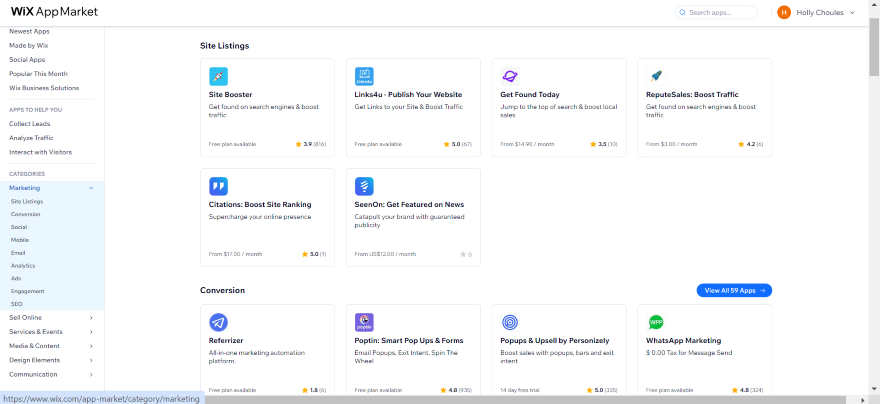
Another one of Wix’s key features is its powerful editor. Giving you more creative control over your website than Weebly does, you’ll find plenty of options allowing you to customize your website how you see fit.
When you sign up, you can choose from over 800 professional Wix templates covering a variety of industries. You can use the search bar to find exactly what you’re looking for, by typing in “technology” for instance, or by clicking through the five categories provided to narrow down your options.
After picking your template, you’ll get creative control over your website’s unique design, more so than you would with Weebly’s more limited block-based editor. The Wix editor’s drag-and-drop feature is easy to get the hang of regardless of your technical experience. It’s simple to drag your desired elements – such as videos, photos, and forms – and arrange them on the page until you’re happy with the overall design.
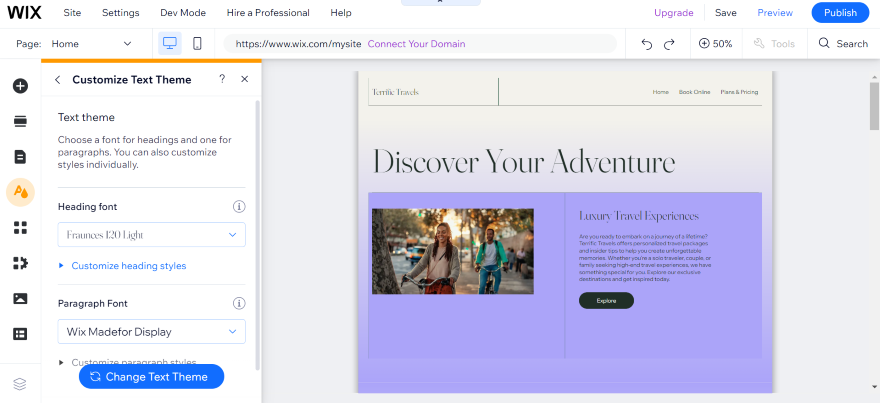
However, it’s worth noting that Wix’s range of options can also be a downside to the platform. With such a wide range of design tools available, you may find Wix’s editor overwhelming to use and that it takes quite some time to work out where everything is. If that worries you, we recommended Squarespace’s editor instead since it’s the easiest one to use.
How Much Does Wix Cost?
On Wix’s pricing plans, you have four different options to choose from: Light, Core, Business, and Business Elite. The Light plan is the cheapest at $17 per month, while the Business Elite is the most expensive costing $159 per month (billed annually). Each plan comes with storage space, marketing tools, and the ability to add collaborators. Though if you need to access site analytics or use ecommerce, you’ll have to pay for the Core plan costing $29 per month.
At a glance, the price jump from $17 to $159 per month is expensive, so you might want to consider a more affordable website builder (like GoDaddy or Hostinger) if you’re building a website on a budget.
Wix also offers a great free plan (which we also consider the best free website builder on the market), alongside a 14-day money back guarantee if you do end up purchasing a paid plan but aren’t satisfied with the results. You can also get 10% off your plan if you use the code “TAKE10” at checkout!
The free plan isn’t without its limitations though. Your free website will feature Wix ads alongside a wixsite URL. This can make your website look unprofessional to visitors, since the Wix name will be visible and can take away from your business’ own branding.
Are you a Weebly user interested in switching to Wix? Read our Wix vs Weebly comparison before you make your decision.
Weebly Alternative #2: Squarespace
5 out of 5 stars
Overall rating: 4.8/5
If you feel limited by Weebly’s standard website templates, then you’ll want to check out Squarespace’s offering instead, especially if you’re in a creative industry. Since Squarespace is passionate about providing users with design-centric templates, you’ll find sleek, modern designs you can tweak to reflect your unique creative identity.
Squarespace also offers the easiest editor to use, scoring 5 out of 5 in our ease of use testing due to how simple it is to change the colors, fonts, and other design elements of your website. You won’t have to worry about picking up a complicated system right off the bat.
Listed below are Squarespace’s key pros and cons to keep in mind:
| Squarespace Pros | Squarespace Cons |
|---|---|
| In comparison to other Weebly alternatives, Squarespace’s pricing is good value for money. Its plans range from $16 - $52/mo (billed annually) and you can also get 10% off your purchase with the code “WBE10” at checkout. | Squarespace doesn’t have a free plan like other competitors such as GoDaddy. Once the free trial is over, you’ll need to purchase a paid plan to keep using it. |
| If you need a stunning design to match your personal brand, Squarespace will provide you with stylish templates to choose from. | Although Squarespace has an app store, it has less extensions to choose from in comparison to a website builder like Wix. |
| Squarespace has the easiest editor to use. Users find that the drag-and-drop editor makes it easy to organize content on the page. | If you need more advanced ecommerce options, then we recommend a platform like Shopify over Squarespace. Squarespace’s ecommerce offering isn’t as advanced, especially if you need to scale up your online store. |
Key Squarespace Differences
The biggest difference between Squarespace and Weebly is Squarespace’s focus on high-quality design. When you’re using Squarespace’s website builder, you’ll notice a range of eye-catching templates to choose from. Picking a strong design is vital if you want to encourage users to keep looking through your website. You’ll want to make a positive first impression through a stunning homepage design.
Weebly’s designs are a little outdated in comparison. Due to its poor mobile formatting and restrictive editor limiting how much you can customize templates, we recommend Squarespace over Weebly. It’s an excellent alternative if you’re keen to create a stylish website for visitors.
After signing up for Squarespace, we were able to explore a range of professional templates spanning categories such as real estate, gaming, photography, restaurants, and more. We were also able to narrow down the templates via the search filter, allowing us to organize results by industry and the exact features we wanted our design to have.
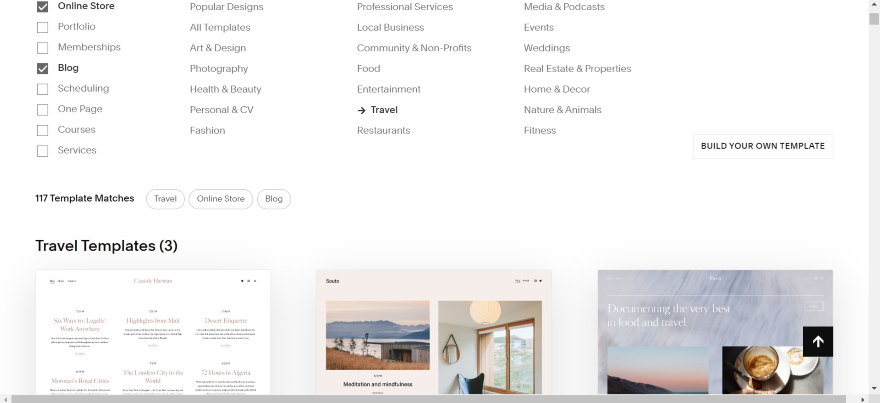
The other thing to note about Squarespace is its seamless drag-and-drop editor. Currently the easiest editor to use on the market, you’ll have no issue customizing your website how you see fit. You can add a range of content blocks to your website, such as sign up forms and accordions, and customize them until you’re happy with the final result.

When adding a content block to a website, you’re also greeted by a handy grid overlay. Don’t be afraid to move your blocks around since the grid guidelines make it impossible to mess up your design – the overlay will keep everything in place.
How Much Does Squarespace Cost?
In comparison to other website builders, 14-day free trial first, but its price plans that range from $16 to $52 per month (billed annually) are reasonably priced.
With each plan, you’ll receive key features such as unlimited bandwidth, SEO tools, and a free custom domain name. However, if you’re a creative who’d also like to sell your products or services online, you’ll need to opt for the Business plan priced at $23 per month.
Though Weebly’s cheapest plan is only $10 per month, making it more affordable overall, the features you receive will be more limited. You won’t get unlimited storage space or have the ability to remove ads from your webpage.
Before you make your choice, it’s worth noting that Squarespace doesn’t offer a free plan like Weebly does. If you’d like to build your website for free, then you’ll need to bring your attention to competitors like Wix or GoDaddy instead.
Weebly Alternative #3: Shopify
4.5 out of 5 stars
Overall rating: 4.5/5
Is the main purpose of your website to sell products online? If that’s the case, then you’ll want to try out Shopify’s powerful ecommerce website builder.
Although Weebly has its own ecommerce option that is powered by Square, Shopify’s wider range of sales features, like different shipping and payment options, means you’ll be able to easily scale up your store and keep track of a large inventory.
Weebly is suitable for smaller stores, but it doesn’t support longer-term growth like Shopify does. That’s why we recommend Shopify for fast-growing stores because it provides you with the tools you’ll need to sell a high volume of products.
Before you learn more about Shopify, here are its key pros and cons:
| Shopify Pros | Shopify Cons |
|---|---|
| Shopify’s ecommerce platform is the best you’ll find. Its sales features are designed to help business owners thrive. | Budgeting will be an issue if you use Shopify, with prices increasing from $29/mo to $299/mo between its three main plans. |
| If you have a large number of products to sell, you’ll be able to use Shopify’s strong inventory management tools to keep track of everything. | Unlike a platform like Wix that has more in-built features, you’ll often be reliant on third-party apps with Shopify. If you need to purchase a few and add them to your store, this can get costly over time. |
| Worried about unsafe transactions? Shopify keeps its merchants safe through key security measures like fraud protection and 2-step authentication. | Free templates are limited with Shopify since only 12 of them are free to use. Expect to pay for a more advanced template. |
Key Shopify Differences
Shopify’s ecommerce platform is designed specially for merchants to set up and scale their online store; which sets it apart from Weebly from the outset. After conducting our research, we found that Shopify had the best sales features overall, so here are some of Shopify’s most significant sales features you’ll want to check out:
- Multiple shipping options that include four different couriers: FedEx, USPS, UPS, and DHL express. You can also use Shopify Shipping to print off discounted shipping labels and save money.
- POS that facilitates in-person sales. To use this particular sales feature, you’ll need to purchase POS hardware (the most common form being a card reader) which will allow you to accept in-person payments. This means you sell your products anytime, anywhere, helping you manage both digital and brick-and-mortar sales from one place.
- Abandoned cart recovery detecting if a customer has left products in their basket. This way Shopify will send out an automatic email to persuade users to go through with the purchase, or act as a gentle reminder if they’ve simply forgotten.
- Additional App Market extensions that’ll help with sales. Just note, that since Shopify relies a lot more on these apps than competitors like Wix, additional costs can add up over time, so be careful there.
Another key part of running a large online store is being able to keep on top of your inventory. You’ll want to find a process that makes this easy, especially if you’ve used Weebly before and found its fairly basic inventory tools limiting. Thankfully, Shopify offers impressive inventory management tools so you can keep track of a variety of products.
This is especially important if you’re sending a large number of products abroad, since international buyers make up 57% of online shoppers. To keep on top of it all, Shopify offers multi-currency support and international shipping tools helping you manage global rates and custom fees.
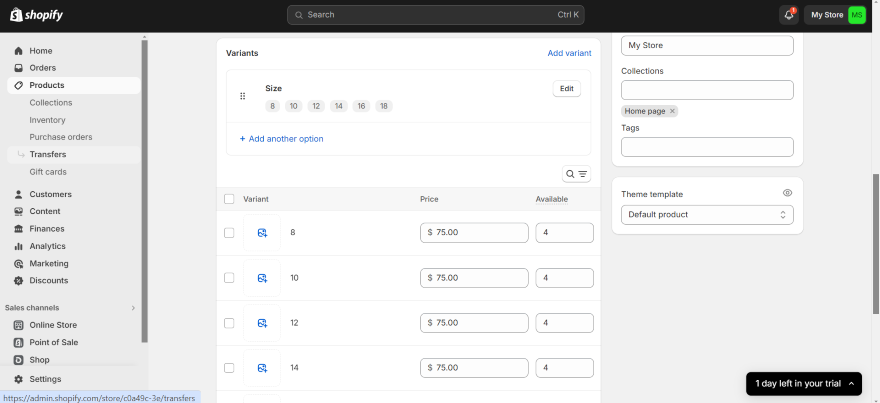
With the latest Shopify Editions Winter ‘24, the platform added even more inventory management tools to help you track your products effectively. Among the new additions, Shopify improved the ability to display multiple product variants, increased bundles from 10 products to 30 products, and lets you pick different inventory locations based on the regional marketplaces you’re selling in.
How Much Does Shopify Cost?
In comparison to other website builders on the market, Shopify’s pricing can get costly, especially when switching to the more advanced plans. Overall, Shopify’s three plans range from $29 to $299 per month (billed annually).
You’ll also need to take the number of third-party extensions you need into account. Prices can add up there if you download a few since they’re not always free.
However, once you’ve finished your 3-day trial, you can opt into Shopify’s first month for only $1 deal. It’ll give you enough time to test out Shopify’s ecommerce offering first before making any long term decisions.

Despite the high price points, we recommend Shopify if you’d like to migrate from Weebly and expand your business, or have a large number of products to sell. All of its key sales features will give you room to scale up and make a profit.
Weebly Alternative #4: GoDaddy
4.5 out of 5 stars
Overall rating: 4.4/5
If you’re new to website building, setting up can seem like a daunting task. However, if you’re a small business who needs help with the entire process, we recommend GoDaddy’s website builder. Its combined customer support, seamless website generator tool, and beginner-friendly editor makes it a good fit for anyone just starting out.
Be sure to read GoDaddy’s pros and cons below if you’d like a general overview of the platform:
| GoDaddy Pros | GoDaddy Cons |
|---|---|
| GoDaddy’s plans are good value for money in comparison to competitors like Shopify and Wix, with plans starting from $9.99/mo. | Although it’s easy to generate a website with GoDaddy, the designs can tend to look generic – especially in comparison to other builders like Squarespace or Wix. |
| If you’re a beginner, you’ll find GoDaddy more accessible than other builders. You have access to 24/7 support for any questions, alongside easy-to-follow help resources. | GoDaddy’s ecommerce tools aren’t that powerful, with competitors like Shopify offering stronger features. You’ll need to look into other website builders if you want to scale up an online store. |
| To cut down your setup times, you can use GoDaddy’s AI generator. It lets you create a new website in under 30 seconds. | You may find GoDaddy’s editor restrictive due to its minimal customization options, so look elsewhere if you’d prefer to have more creative control over your website’s design. |
Key GoDaddy Differences
With GoDaddy, you’ll be able to set up your website fast, even if you’re lacking knowledge in the tech or coding department. Designed to be user-friendly for beginners, GoDaddy will lead you through the entire process and leave you with a professional page that represents your business well.
GoDaddy’s ADI editor plays a huge part in making designing a website easy. The tool will ask you key questions on your desired website, such as the industry you’re in, and then will get to work and design a website for you. According to our research, the process can be completed in under 30 seconds. So, even if you’re a beginner, GoDaddy will sort out the more technical parts of the process for you.
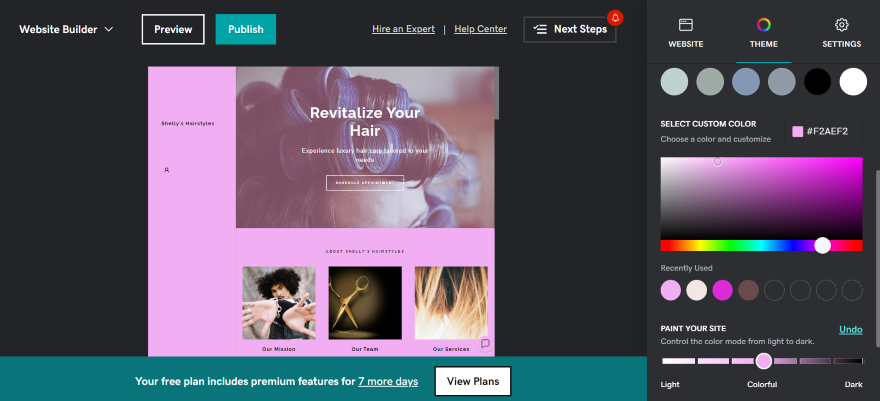
Once your website is loaded, you’ll have a few customization options to play around with. This includes inserting different elements onto your page, or playing around with the color, fonts, and different theme variations until you’re happy with the finished product. However, these tools aren’t as extensive as the ones you’ll find with Wix or Squarespace, so try out those website builders if you want more creative control.
If you encounter any mishaps along the way, GoDaddy also provides multiple phone lines and a 24/7 live chat. This makes it easy for beginners and small businesses to receive the help they need if they get stuck. Alongside this support, you can also access useful materials from GoDaddy’s knowledge base and community forums.

How Much Does GoDaddy Cost?
But how do GoDaddy’s pricing plans compare to its competitors? Well, GoDaddy is generally great value for money. Besides its free plan, which is great if you want to test out some key features, you’ll find affordable plans ranging from as little as $9.99 per month (billed annually).
It’s a great price point for beginners, alongside small businesses who want a professional page on a budget. Even on the cheapest plan, you’ll receive key features like an SSL certificate for security, marketing tools and analytics, the ability to create and publish custom videos, and the GoDaddy Studio tool assisting you with content creation.
Though Weebly’s first paid plan is slightly cheaper at only $10 per month, you won’t receive such a wide range of features. GoDaddy’s plans offer a more seamless integration with other GoDaddy services, including email marketing and domain registration. This is why we recommend switching to GoDaddy if you want a better range of features at a reasonable cost.
Weebly Alternative #5: Hostinger
4.5 out of 5 stars
Overall rating: 4.2/5
When building your ideal website, we understand how time consuming it can be to create content for each page. Because of this, we recommend Hostinger’s website builder if you want to save time. Thanks to its dedicated AI features, you can take a hands-off approach to content creation and let the tools do all of the heavy lifting.
Weebly, which doesn’t have any AI features, focuses on a more manual website building experience where you’ll have to do most of the work yourself. Because of this main difference, we recommend Hostinger if you’re interested in AI and would like to use specialized tools to generate content for your website.
Ahead of exploring Hostinger’s AI website builder in more detail, here are a few pros and cons to mull over:
| Hostinger Pros | Hostinger Cons |
|---|---|
| With Hostinger, you’ll find deals from as little as $2.99/mo. This will help you save money if you’re sticking to a strict budget. You can even save more by using the code “WBE” at checkout for 10% off. | Hostinger doesn’t offer a free plan. To test out its features, you can use its 30-day free trial or you'll need to purchase a plan before you create a website. |
| Hostinger provides users with a hand-off approach to content creation. Whether you need to create text or a logo, you’ll find a suitable tool you can use to create one. | Overall, Hostinger’s generated template can look quite simplistic. Although it’s fine if you don’t need a complicated website, we recommend Squarespace or Wix for more sophisticated designs. |
| With the AI website generator, you can get your website set up quickly – great if you’re under time constraints. | You won’t find an app market on Hostinger, which can be frustrating if you want to add extra functionalities to your website. For that, we recommended builders like Shopify or Wix instead. |
Key Hostinger Differences
Hostinger is the second easiest website builder to use and is apt at keeping the website making process simple. During the setup process, you’ll be able to take a hands-off approach to website design, most notably via its AI website builder.
During the process, you’ll have three key prompts to answer: your business name, the type of website you need, and a brief description of what your brand offers. Once you’ve filled in these key details, Hostinger’s AI will design your website.
If you’re not 100% happy with the finished product, you will be able to tweak your design afterwards by editing images and changing the font. However, your customization options will be limited – for greater creative control, opt for a more stylised website builder like Squarespace instead.
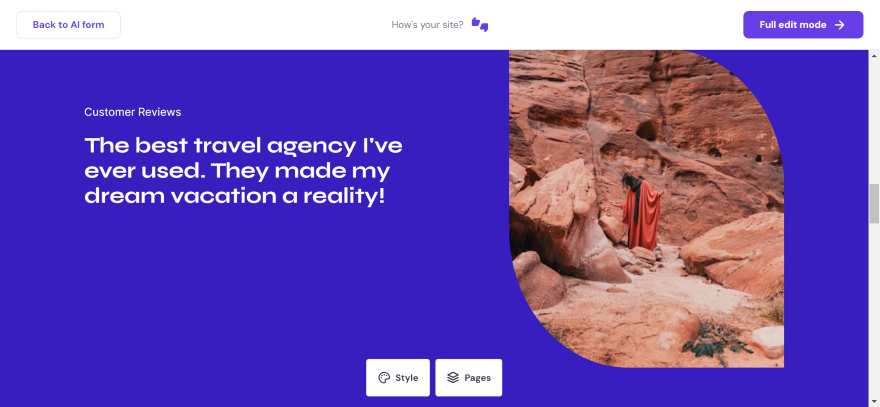
Of course, Hostinger has other AI tools you can explore. For instance, if you need to save time generating content, you can make use of the AI image generator to create vibrant images for your webpage, or give the in-text AI content generator a spin which will draft your text for your website. But do note, since AI content tools are still a relatively new technology, the final results may vary.
How Much Does Hostinger Cost?
Hostinger’s pricing is definitely one of its strong points. Contrasting other website builders on the market who have increased its prices over time, Hostinger’s main plans remain affordable. Just be aware that these plans are spread across longer contracts that range from 12 to 48 months.
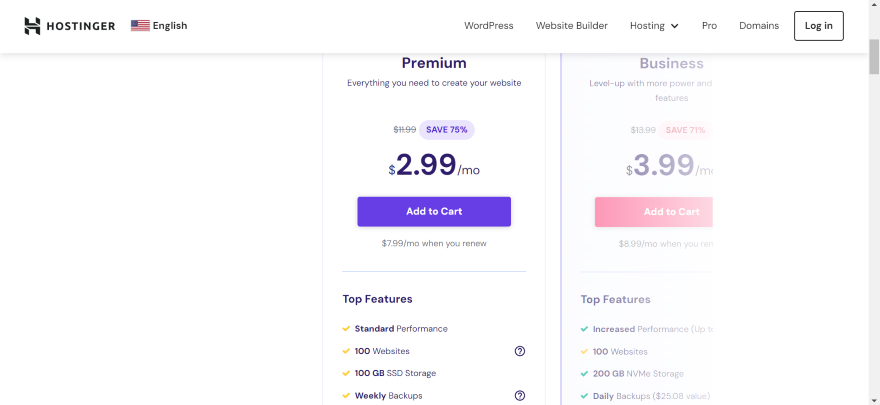
On Hostinger’s website, you’ll find that the cheapest plan is only $2.99 per month and is spread across a longer billing cycle of 48 months – ideal if you have a strict budget and want to keep your monthly costs to a minimum. Additionally, the plan comes with essential features, such as a free domain, unlimited bandwidth, 24/7 customer support, and the ability to create up to 100 websites if needed.
However, we understand that not everyone will want to sign up to such a long term, 48-month plan. If that’s the case, you could opt for another deal instead. To pay across a 12 month period on the Premium plan, you’ll only need to pay $3.19 per month which is still great value for money.
Despite these affordable plans, Hostinger doesn’t offer a free plan. Other website builders like Wix and GoDaddy do, so you’ll need to seek out one of those alternatives to Weebly if you’d like to set up a free website.
How Easy Is It To Migrate From Weebly?
Weebly doesn’t make it easy to switch to other platforms. When it comes to your new platform, you won’t be able to import all of your previous website’s features, like its specific layout or theme, into your new website. Also, if you have text to move over (i.e from a blog), you will need to copy and paste this content into your new pages.
However, if you know that changing to another platform will improve your website’s quality overall, the switch will be worth the effort. Remember to back up your content before you start making the switch and save as much as you possibly can.
Buying Guide: What To Look for in a Website Builder
Still wondering which alternative to Weebly is best for you? To help you decide, it’s worth considering why you’re interested in another platform and what features you’ll need to succeed online. We’ve put together a few pointers below so you can evaluate each alternative based on your unique needs.
Currently using Weebly and want to switch? Here are three key questions to ask yourself:
- What do you like about Weebly? What key features does Weebly already have that you want in your next platform? For instance, if you enjoy integrating extensions from the app store, then it’s worth considering a platform like Wix or Squarespace instead.
- What do you dislike about Weebly? Is Weebly lacking something you desperately need? This could include its limited scalability for online stores, making Shopify a better option.
- What features do you need to keep? Before you switch, you’ll need to ensure that the platform you’ve picked has the key features your website still needs. As an example, we wouldn’t move to Hostinger if you enjoy using Weebly Promote’s in-built email marketing tool.
Once you’ve asked yourself these key questions, it’s time to decide which website features you want the most based on your unique needs. These key factors below will give you a head start:
Limited knowledge of website builders? Look for:
- Easy-to-follow resources or tutorials
- Prompt assistance from 24/7 customer support
- An intuitive editor you can pick up easily
Is your main goal to sell products or services? Look for:
- Inventory management that can support a large quantity of products
- Varied payment methods
- Multiple shipping options
- Scheduling tools so you can set up meetings with potential clients
Is your budget limited? Look for:
- Free features, such as free themes or free extensions
- Fairly priced plans that include the key features needed to set up
- Regular special offers
- Low transaction fees
Need to set up fast? Look for:
- AI website builders designed to generate your pages within seconds
- Speedy customer support for quick answers
- Pre-built templates so you can spend less time on design
If you’re still unsure, why not try our quick quiz to receive a personalized recommendation?
How We Tested Each Website Builder
To make sure you find the best alternative to Weebly, we examined each platform through the lens of our rigorous website builder research. This research included our hands-on experience, meaning that we know the ins and outs of each competitor on this list.
All of the website builders were measured via key criteria, including design functionality, ease of use, and value for money. The results of our testing has influenced our recommendations on this page, making sure you pick out the best website builder tailored to your unique needs.
Weebly Alternatives Summary
Based on the research above, it’s clear that Wix is the best alternative to Weebly. Suitable for a variety of markets and niches, Wix is the best overall website builder because of the creative freedom it gives users, the wealth of features offered, and its ecommerce functionality – all of these positives contribute to Wix’s strong 4.9 out of 5 score overall in our research.
Although Wix is the best Weebly alternative overall, that doesn’t mean any of the other website builders listed won’t be a good fit for you. These platforms could also be a suitable choice based on what you’re looking for. Here’s a quick round-up of each option and who they’re best suited to:
- Squarespace: If you’re a creative who wants to showcase their work in style, then Squarespace is your best bet. Its design-centric templates and stylish customization options will help you set up a website that best suits your aesthetic tastes.
- Shopify: Are you a business with plans to scale up your online store? If that’s the case, then Shopify’s sales features and great inventory management tools will allow you to sell your products around the world.
- GoDaddy: The best website builder for beginners who want to build a website fast, GoDaddy’s speedy website generator and 24/7 customer service offers a straightforward experience that keeps set up times to a minimum.
- Hostinger: Thanks to its extensive AI tools, Hostinger offers a seamless, hands-off approach to website building. This is suitable for anyone interested in this exciting tech who wants to easily generate content for their website.
Leave a comment